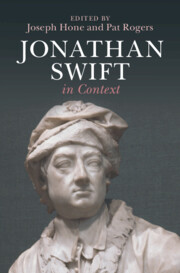Book contents
- Jonathan Swift in Context
- Jonathan Swift in Context
- Copyright page
- Contents
- Notes on Contributors
- Preface
- Acknowledgements
- Chronology
- Abbreviations
- Part I Personal
- Part II Publishing History and Legacy
- Part III Literary Background
- Part IV Genres
- Part V The External World
- Part VI Social and Intellectual Topics
- Chapter 35 Philosophy
- Chapter 36 Science
- Chapter 37 Race
- Chapter 38 Material Culture
- Chapter 39 Gender
- Chapter 40 Colonialism
- Chapter 41 The Body
- Chapter 42 Demography
- Chapter 43 Food
- Chapter 44 Economics
- Further Reading
- Index
Chapter 38 - Material Culture
from Part VI - Social and Intellectual Topics
Published online by Cambridge University Press: 02 May 2024
- Jonathan Swift in Context
- Jonathan Swift in Context
- Copyright page
- Contents
- Notes on Contributors
- Preface
- Acknowledgements
- Chronology
- Abbreviations
- Part I Personal
- Part II Publishing History and Legacy
- Part III Literary Background
- Part IV Genres
- Part V The External World
- Part VI Social and Intellectual Topics
- Chapter 35 Philosophy
- Chapter 36 Science
- Chapter 37 Race
- Chapter 38 Material Culture
- Chapter 39 Gender
- Chapter 40 Colonialism
- Chapter 41 The Body
- Chapter 42 Demography
- Chapter 43 Food
- Chapter 44 Economics
- Further Reading
- Index
Summary
Swift’s world was a material one, influenced by his experiences of the institutionalisation of British imperialism, mercantile capitalism, science, medicine, philosophy, the book trade, party politics, and aesthetics. This chapter focuses on a single category of material culture of especial importance in Swift’s writings: consumer goods. The early part of this chapter sets out the essential background on the ‘consumer revolution’ in the early eighteenth century, before addressing its influence on Swift’s writings: in particular the pamphlets concerned with Irish manufacturing, and his fascination with the material culture of women’s dressing rooms.
- Type
- Chapter
- Information
- Jonathan Swift in Context , pp. 303 - 310Publisher: Cambridge University PressPrint publication year: 2024

